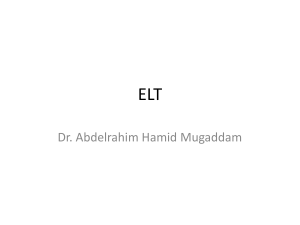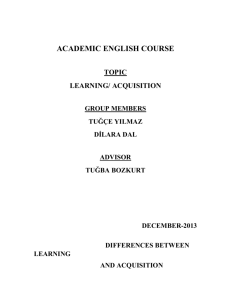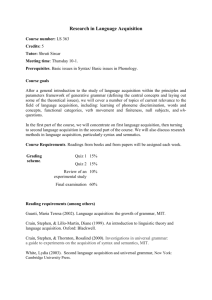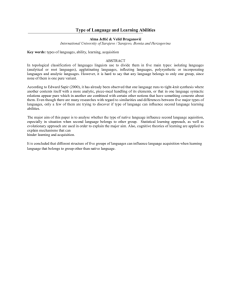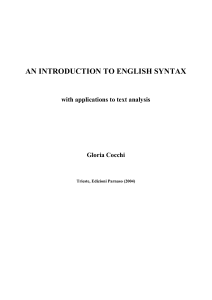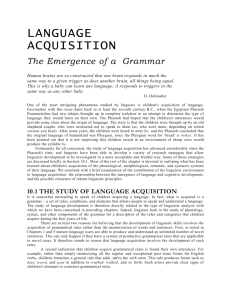Language Acquisition theories
advertisement
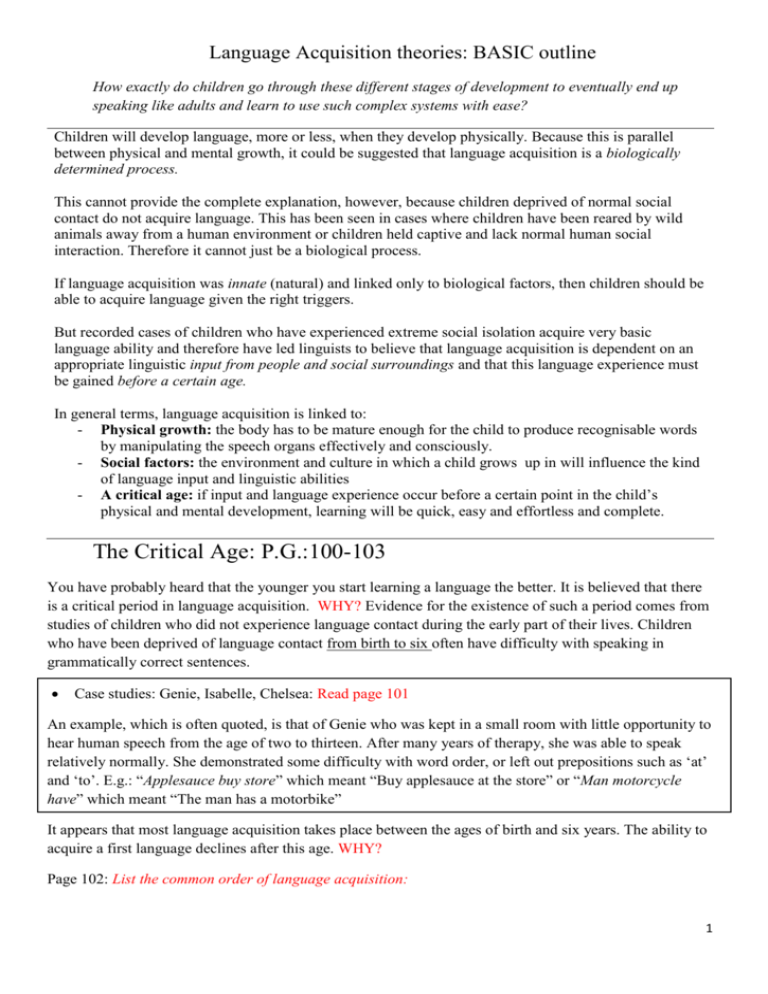
Language Acquisition theories: BASIC outline How exactly do children go through these different stages of development to eventually end up speaking like adults and learn to use such complex systems with ease? Children will develop language, more or less, when they develop physically. Because this is parallel between physical and mental growth, it could be suggested that language acquisition is a biologically determined process. This cannot provide the complete explanation, however, because children deprived of normal social contact do not acquire language. This has been seen in cases where children have been reared by wild animals away from a human environment or children held captive and lack normal human social interaction. Therefore it cannot just be a biological process. If language acquisition was innate (natural) and linked only to biological factors, then children should be able to acquire language given the right triggers. But recorded cases of children who have experienced extreme social isolation acquire very basic language ability and therefore have led linguists to believe that language acquisition is dependent on an appropriate linguistic input from people and social surroundings and that this language experience must be gained before a certain age. In general terms, language acquisition is linked to: - Physical growth: the body has to be mature enough for the child to produce recognisable words by manipulating the speech organs effectively and consciously. - Social factors: the environment and culture in which a child grows up in will influence the kind of language input and linguistic abilities - A critical age: if input and language experience occur before a certain point in the child’s physical and mental development, learning will be quick, easy and effortless and complete. The Critical Age: P.G.:100-103 You have probably heard that the younger you start learning a language the better. It is believed that there is a critical period in language acquisition. WHY? Evidence for the existence of such a period comes from studies of children who did not experience language contact during the early part of their lives. Children who have been deprived of language contact from birth to six often have difficulty with speaking in grammatically correct sentences. Case studies: Genie, Isabelle, Chelsea: Read page 101 An example, which is often quoted, is that of Genie who was kept in a small room with little opportunity to hear human speech from the age of two to thirteen. After many years of therapy, she was able to speak relatively normally. She demonstrated some difficulty with word order, or left out prepositions such as ‘at’ and ‘to’. E.g.: “Applesauce buy store” which meant “Buy applesauce at the store” or “Man motorcycle have” which meant “The man has a motorbike” It appears that most language acquisition takes place between the ages of birth and six years. The ability to acquire a first language declines after this age. WHY? Page 102: List the common order of language acquisition: 1 The Theories pg: 102-108 Language theorists disagree on how children learn their first language. Some say that children learn language by imitating people they hear talking to them. Others believe that children can learn any language in infancy and that they have an innate ability. While others believe it is a combination of environment and human experience. There have been a number of different attempts to explain this. There are four key linguistic approaches to language acquisition: Behaviourist Approach: imitation, reinforcement and corrections , p.g. 103 Based on B.F Skinner’s behavioural theory, children learn to speak by imitating the language structures they hear. Parents/ caretakers automatically reinforce (positively) and correct children’s utterances, and this forms the basis for a child’s knowledge of language. It also considers that learning is established through habits as a result of reinforcement and rewards and that learning takes place when experience or practice causes a change in a person’s knowledge or behaviour There are, however, significant problems with this theory of language development. Although imitation is obviously important in learning pronunciation and in acquiring new vocabulary, children do not seem to automatically pick up ‘correct’ forms from imitation. With irregular verbs, for instance, children do not necessarily use the standard forms when they hear adults use it. Instead, they over-extend the language patterns they already know. - Steal= stealed (stole) Grow= Growed (Grew) Equally they may not understand corrections even after repetition and examples. Evidence show that child language acquisition cannot be based on imitation and reinforcement alone. Although children may add new words to their repertoire by using words with a naming function an adult has just introduced, they rarely imitate speech that is not directed at them. Equally they do not appear to assimilate syntactical structures by imitation. Above all, this approach fails to explain how children are able to produce structures that they have not heard before. Doesn’t explain actually understanding of structures meaning and different uses Cognitive Approach The cognitive approach links language acquisition directly to intellectual development. The theory suggests that children can only use a certain linguistic structure when they understand the concept involved. For instance: children will only understand past tense when they understand the concept of past time. They must have learnt to recognise and conceptualise visual and physical differences before they can talk about size and colour. This approach to language acquisition seems to be most effective in describing linguistic progress during the first one and a half years. Even at this stage, however, it is difficult to make precise connections between cognitive and linguistic development stages. 2 Nativist Theory: Innate Approach p.g.: 108 The nativists believe that children are born with an innate capacity for language development. When the brain is exposed to speech, it will automatically begin to receive and make sense of utterances because it has been ‘programmed’ to do so. Noam Chomsky, an American linguist, suggests that the human brain has a language acquisition device (LAD) or universal grammar. He believes that when children are exposed to speech, the child’s brain will automatically begin to make sense of the speech and fit it into the grammatical categories already in their brain. This device provides children with an innate understanding of the underlying grammatical rules that govern language. It recognises that children need to be exposed to language, trial and error. Also that the exposure acts as a trigger for developing language. All children acquire skills in the same order and speed, and they understand sentences the first time that they hear them. Interactionist Approach Interactionists believe that language develops as the result of the combination of the child’s environment and their uniquely human characteristics. Jean Piaget, a Swiss psychologist, believed that language is not innate or learned, but instead it emerges as a result of the continual interaction between a child’s cognitive development and social development. For instance: children will only understand past tense when they understand the concept of past time. Other researchers have focused on the importance of social interaction : - Structures emerge due to social communicative functions that language plays in human relations. This approach considers many factors: social and linguistic environments, stage or maturation and level of cognitive development: all factors interact with each other. They believe that the way adults modify language is essential to the way children acquire language. Caretakers take their cue from the child in supplying the appropriate and meaningful language experience that the child requires. E.g.: depending of the child’s stage of language development, the caretaker may simplify words, speak slower, clarify, and repeat sentence structures or questions to encourage the child to participate. Attempts at speech are rewarded with extra attention In your opinion, how do children acquire language? Refer to at least two theories. Be critical in your approach. Which theory is applicable to the article ‘Hey baby, let’s talk!’ 3


